Mario Tennis Aces review – a swing and a miss, or game, set and match Nintendo?
T3 dusts off its tennis racquet, pulls on its Lacosts, and eyes up the post-match Pimm's. It's time to play Mario Tennis Aces!

For casual tennis fans there's quite a lot to like about Mario Tennis Aces, with Nintendo's roster of colourful characters delivering a fast and frenetic game of ball hitting action. Poorly tuned in-game special shot mechanics and a squeezed in and dull "Adventure Mode", which must be trawled through to unlock certain in-game content, though, sees The Big N eventually only progress to the next round by the skin of its teeth.
-
+
Fast, frenetic gameplay
-
+
Colourful and vibrant art style
-
+
Dynamic roster of characters
-
-
Adventure Mode is dull
-
-
Special shot mechanics poorly balanced
Why you can trust T3
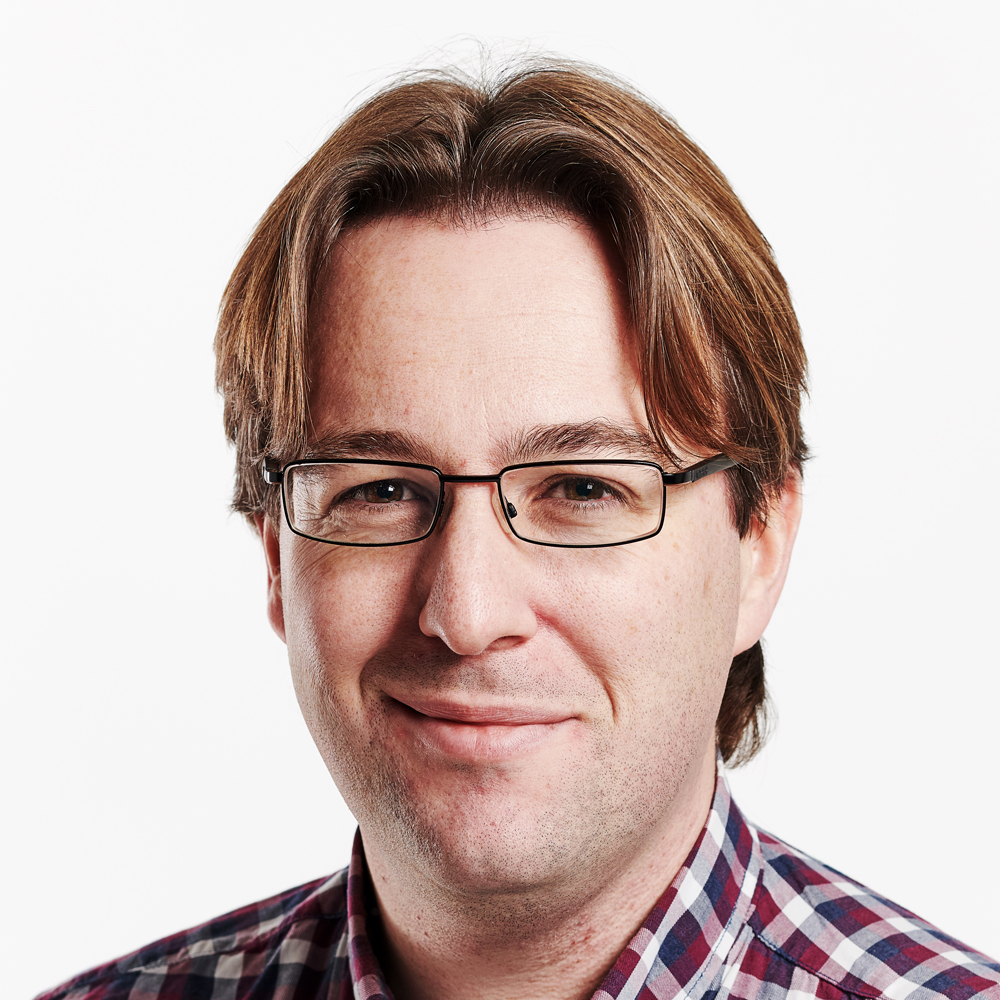
Mario Tennis Aces is a decent tennis game for Nintendo Switch that, for better and worse, adorns the game of racquets and rallies with content that stretches the format of a sports game.
You get to play tennis as Mario, Luigi, Chain Chomp and more, and across a wide selection of colourful and varied courts, too, roaming the base line, sliding in drop shots, and hammering crosscourt winners.
But the enjoyment you'll receive from the game will largely depend on which modes you pick it up to play, whether you are a serious tennis fan, and how much you prize Nintendo's cutesy-yet-conservative depiction of the sport.
I've been playing Mario Tennis Aces for the past couple of weeks and what follows is my considered opinion on the new sporting title for Nintendo Switch.
The review is broken down into sections dealing with characters and game modes, gameplay mechanics and special moves, as well as graphics and audio.
Before we get to the meat of the Mario Tennis Aces review, though, you should watch the game's hype-filled trailer to get a flavour for how it looks and plays, as well as what game modes and features are available.
Mario Tennis Aces review: characters and game modes
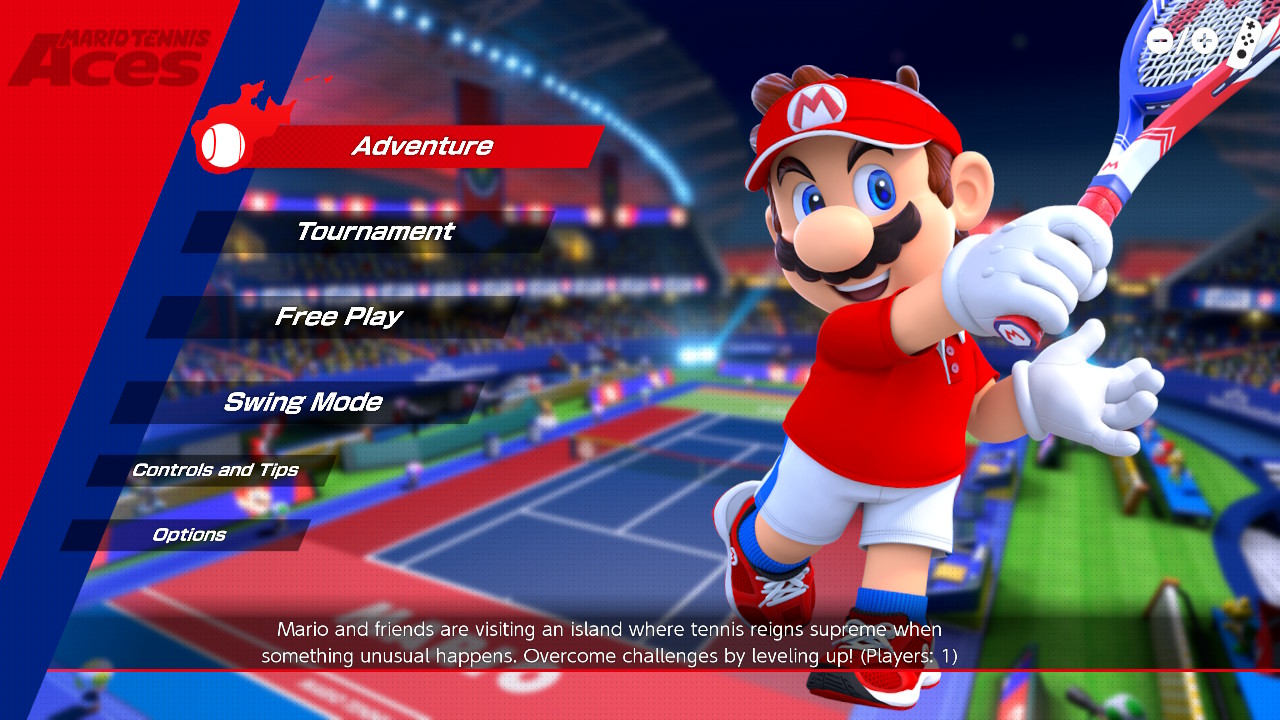
Adventure, Tournament, Free Play and Swing Mode are your play options in Mario Tennis Aces.
There are four main play modes in Mario Tennis Aces: Adventure, Tournament, Free Play, and Swing Mode.
Adventure Mode, the first story mode in a Mario tennis game since 2005's Mario Tennis: Power Tour on GBA, tells the 'story' of a daemon racquet that possesses characters and commandeers 5 magical balls.
Yes, it is total hokum of the highest order and provides the most superficial excuse for Mario and Toad to leave their tennis playing activities to quest across a world map littered with, yep you guessed it, tennis playing enemies.
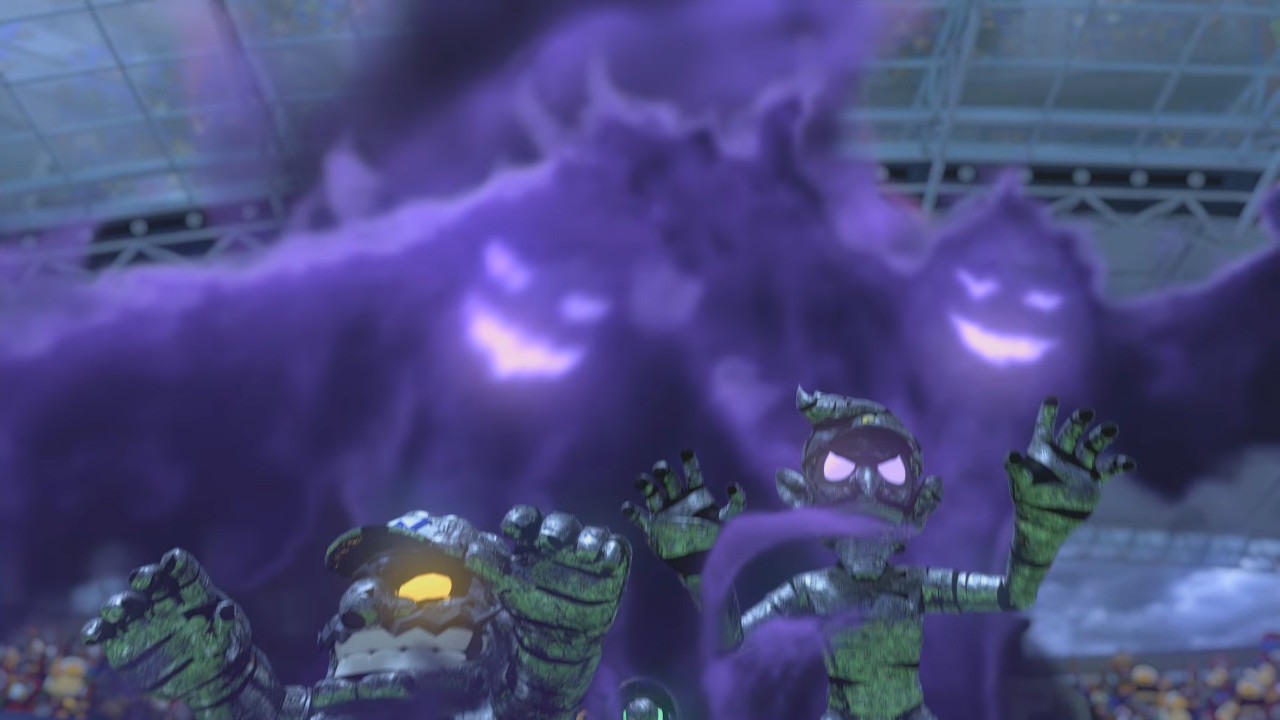
Adventure Mode's 'story' involves a daemon racquet possessing certain characters for nefarious purposes.
The world map, which can be seen in the below image, consists of various themed zones, with each featuring a certain selection of characters, challenges and its own boss.
So, for example, in the map's forest zone you'll meet Donkey Kong and have to beat him. You'll also engage in mini games with piranha plants, and have to beat a huge piranha plant boss. You get the picture.
The quality of these encounters and mini games varies in terms of enjoyment in my opinion, with many turning into frustrating slogs where the normal game of tennis is largely sidelined.
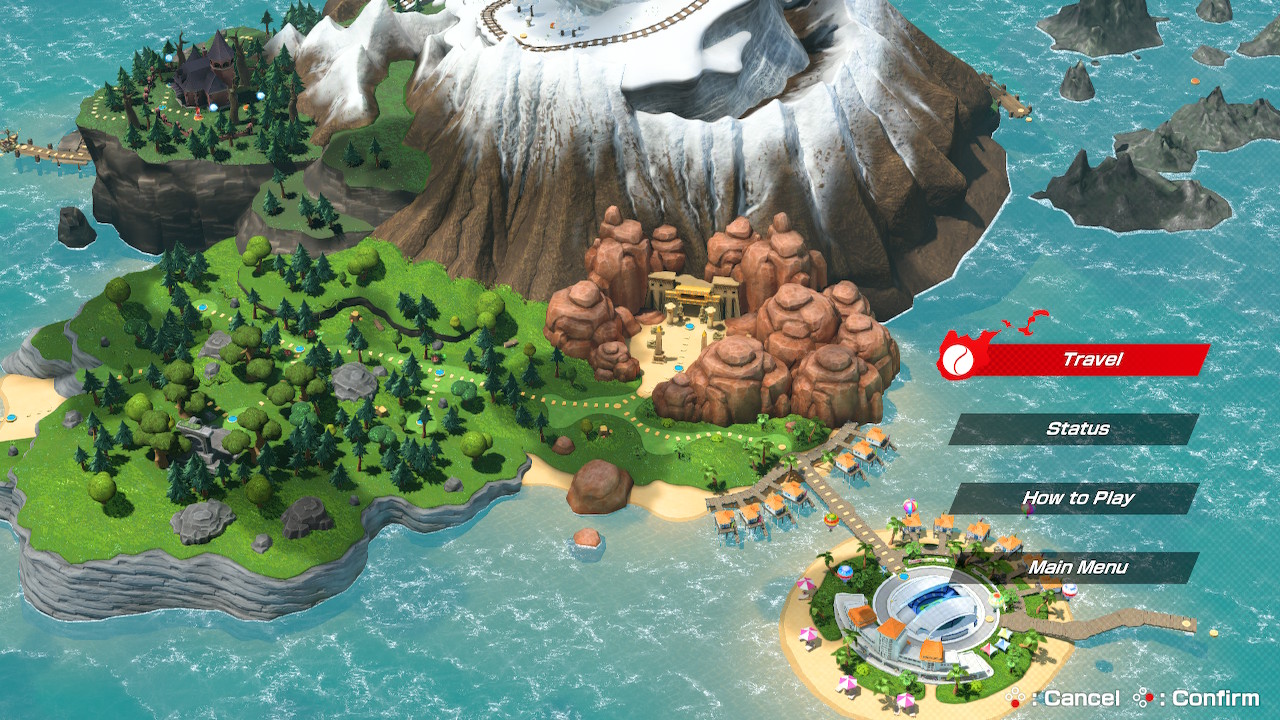
Adventure Mode's world map. You progress through it's zones while playing tennis.
The fact that each encounter is preceded and followed by lengthy verbal exchanges, (text boxes only with largely static models of characters at either side of the screen), adds to this frustration. The quality of the plot and writing is really, really bog average, so having to endure it just so you can, eventually, get round to playing the next match of tennis I found very tedious.
Maybe this won't be an issue with younger players, however, I am guessing that many of them would prefer to just play tennis rather than read a dump truck-load of text boxes.
Also, on this note, I found the fact that if you lost a match or failed a mini game then instead of being offered the chance to replay it instantly on the results screen, you instead get automatically kicked back to the world map to endure more text boxes very annoying. Yes, on the second entry into the level you can hit start to skip the dialogue boxes, but the whole forced exit and entry added to the already sizeable delays between action in Adventure Mode, which certainly was not welcome.
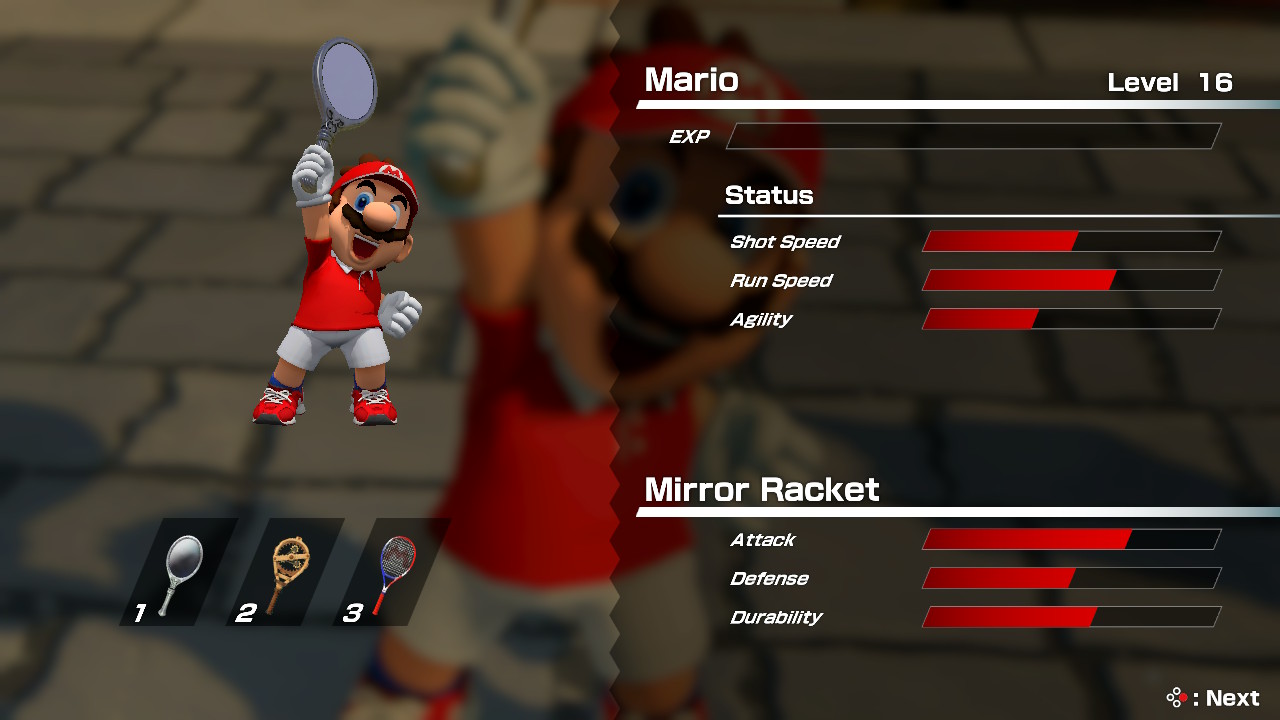
There's a basic level up mechanic in Adventure Mode, as well as the ability to collect and switch racquets.
And you'll really have to engage in all of Adventure Mode's dull text and so-so mini games if you want to make the most out of Mario Tennis Aces, as it is through many of them that you unlock courts and racquets for use, both in the mode and in others.
The various racquets that can be won this way each offer different qualities such as Attack, Defense, and Durability, and are typically themed toward the world map area they are won in (such as an ice racquet in the snow zone).
The courts, meanwhile, follow the same pattern, with each themed toward the area. For example, by beating a challenge in the world map's forest area you unlock a forest/jungle-themed court to play on.
Lastly, Adventure Mode has a built in levelling up mechanic for the player, with each success or failure granting experience points that automatically translate to the character getting better in terms of Shot Speed, Run Speed, and Agility attributes. You get no control over where to upgrade the character, and the whole mechanic seems to basically serve as a way to make the game easier and easier.
Indeed, one of the many tips boxes in Adventure Mode even tells you that if you find a certain encounter to hard, then you should simply grind away at already beaten challenges to level up your character more. Surely the outcome of a game of tennis should rely purely on the player's skill? Not just the amount of time they have grinded to artificially boost their character's abilities? Fun this is not.
Overall, Adventure Mode is decent distraction from the act of just playing tennis matches in Tournament Mode or Free Play, however, its execution leaves a fair bit to be desired, especially as game content is locked behind it.
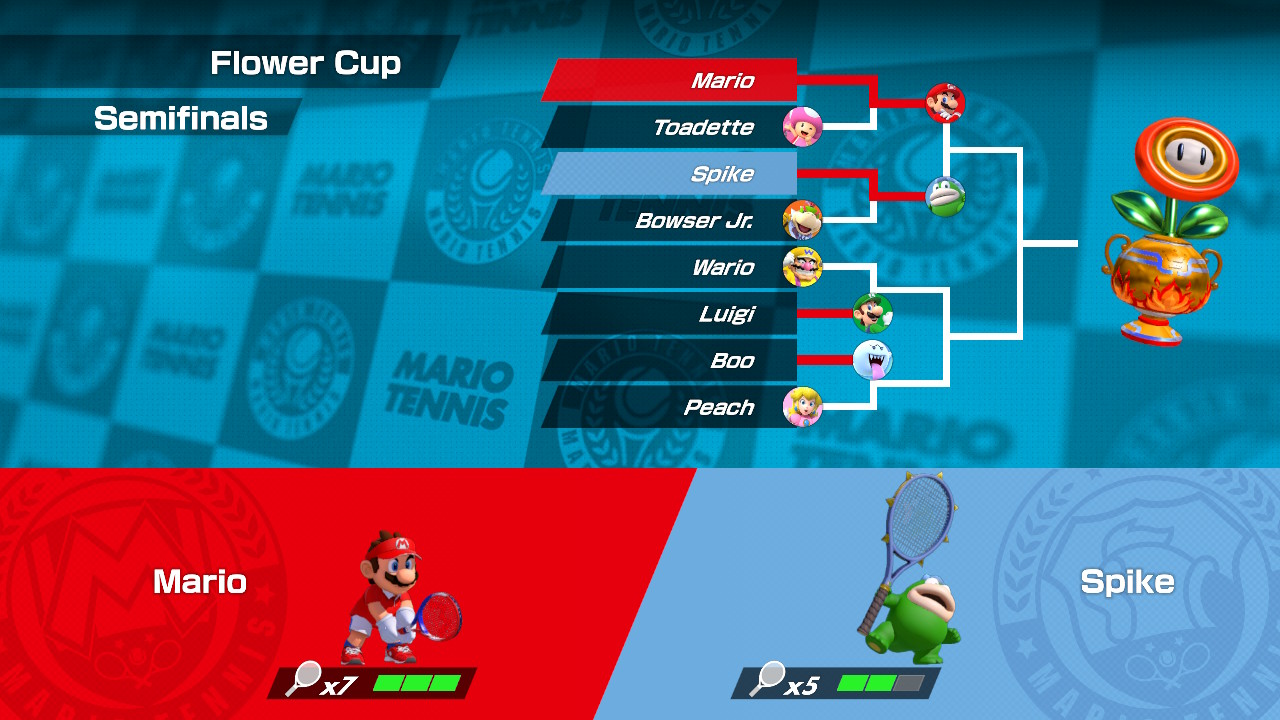
Tournament Mode has a selection of cups for you to win.
Tournament Mode is a classic multi-tier play mode that allows you to select from one of the game's vast roster of characters, which are broken down into various categories like all rounder, speed, power, and technique, and then take on all comers in a series of competitions to win a cup.
In classic Nintendo fashion, these are themed after Mario game power ups, such as the Mushroom Cup, or Star Cup, and vary in difficulty.
I found playing through these tournaments enjoyable, however, they do not take a long time to blast through, so offer limited replay value outside of tackling them with a different character.
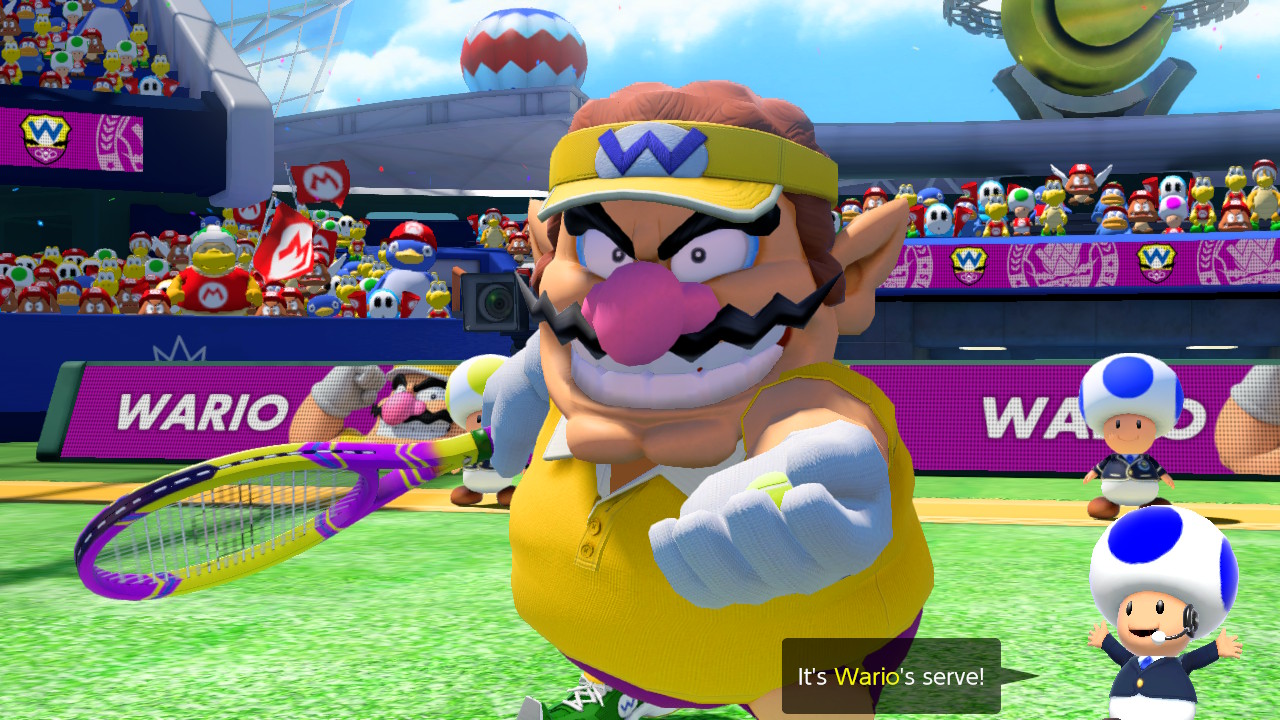
Wario is a power player. His moustache puts in a good performance in Mario Tennis Aces.
Free Play allows you to create a completely custom game of tennis, tweaking the match type, opponent difficulty, play style (which includes Simple mode that removes some of the game's crazier gameplay mechanics such as Energy Gauge, Trick Shots, and breakable racquets) and more.
I was pleased with the selection of options and possibilities this mode delivered, with me easily able to switch up from playing against an Expert opponent on a clay court during the day in Simple mode, to playing a Pro opponent on a different themed hard court during the night.
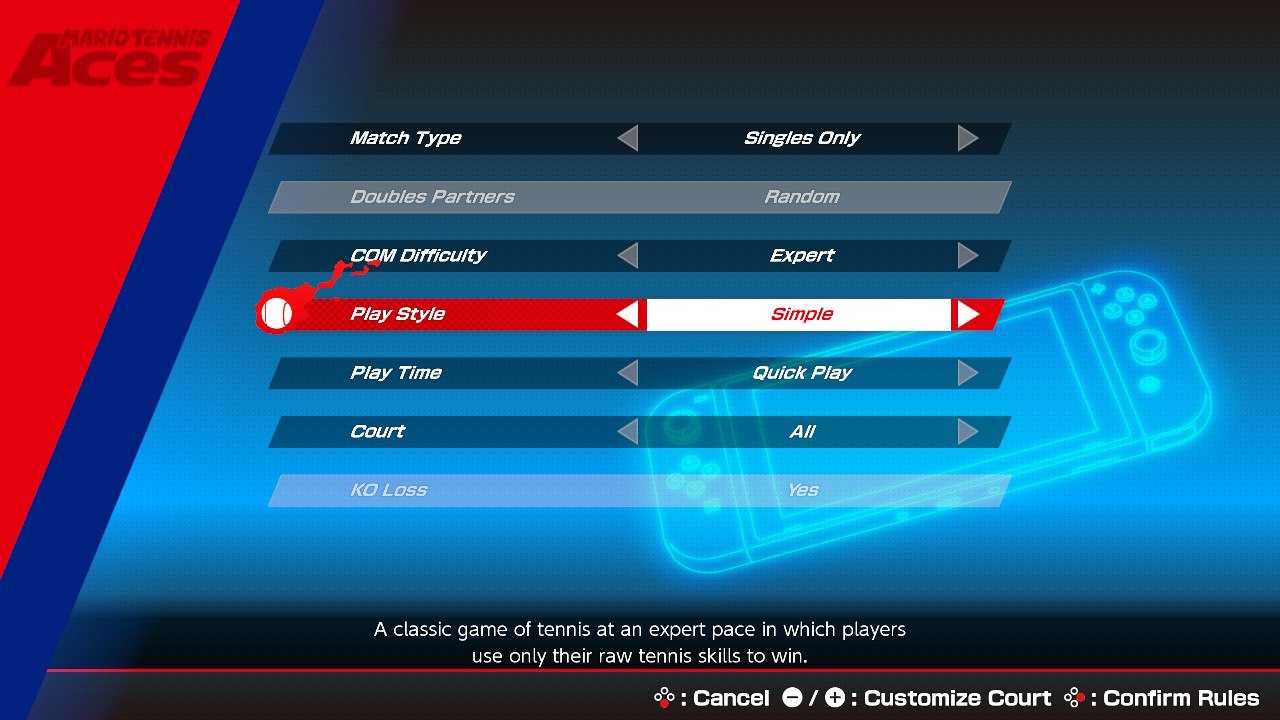
The Simple play style turns off various things like the Energy Gauge and Trick Shots.
Finally, Mario Tennis Aces also comes with a Swing Mode, which is perfect for those players who very much enjoyed Wii Sports Tennis, with you able to use the Nintendo Switch's Joy-Con as your racquet. While this delivers a game that is not a technical as those playing with buttons, you can still play a variety of shots including serves, slices and topspin strikes.
Mario Tennis Aces review: mechanics and special moves
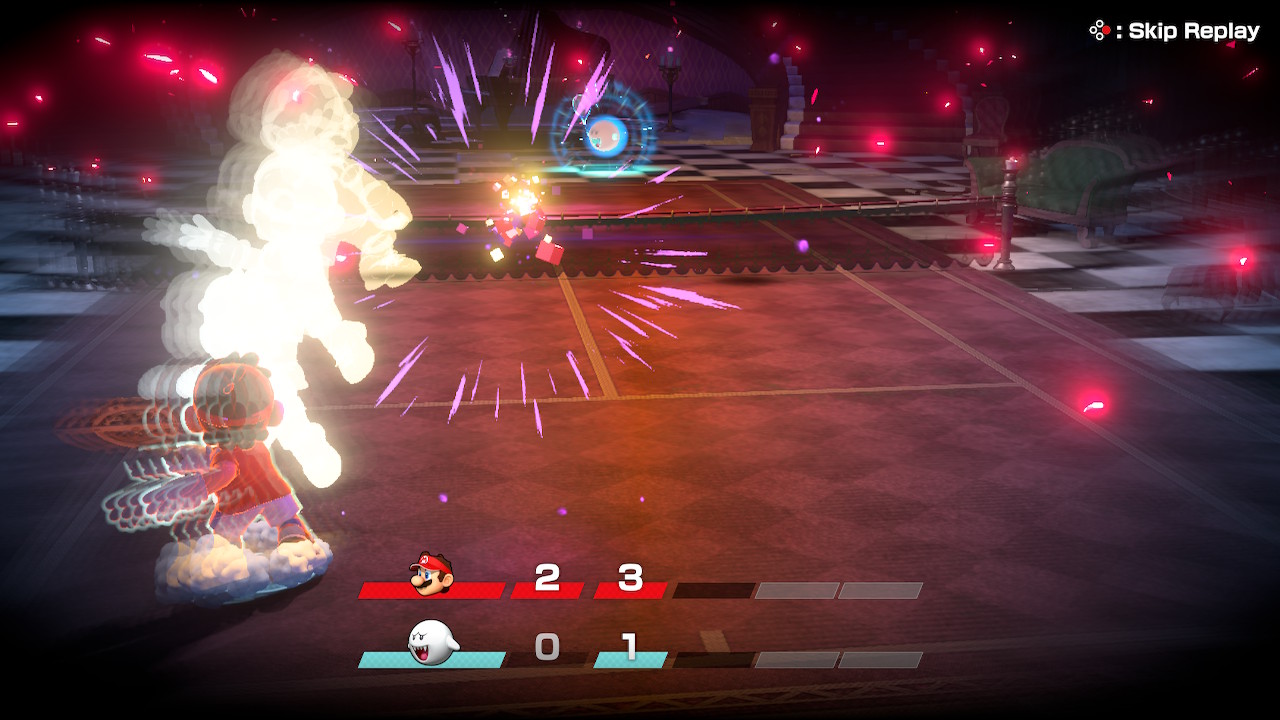
Mario delivers a powerful Zone Shot against Boo.
The core game mechanics of Mario Tennis Aces deliver the basic shots you would expect from a game, such as lobs, topspin, and slices, with each pulled off by pressing a certain button on the right Joy-Con and aimed in direction with the joystick.
These work well in terms of execution, however, I found the ball physics to be a little off and spongy. Rallying backwards and forwards using these basic shot types was never really adrenaline inducing and, while this may be an off-shoot of Nintendo aiming this game very much at a super wide demographic in terms of player age, I felt it left a little to be desired for the mature gamer.
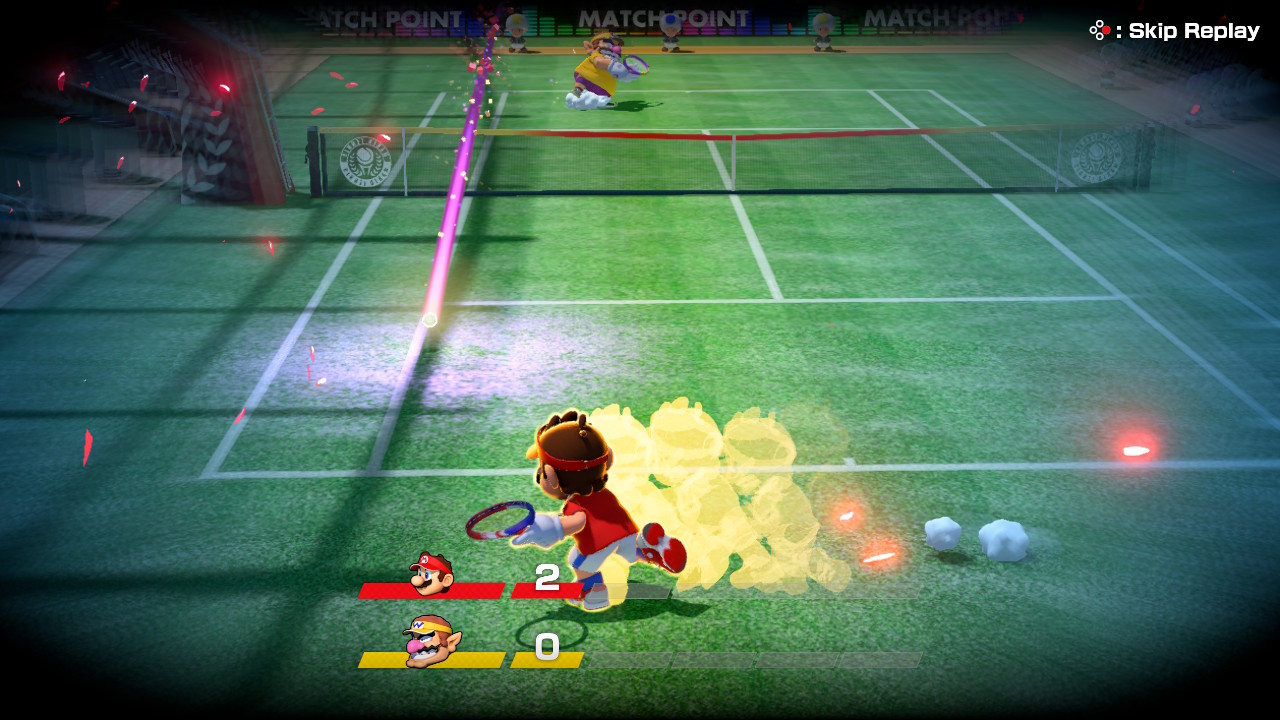
Zone Speed allows you to slow down time in order to make shots that you otherwise would not be able to reach.
Where Mario Tennis Aces gets interesting, both in good and bad ways, is in its super shot special moves, with Zone Shot, Special Shot, and Zone Speed joining Trick Shots as additional tennis playing tools at your disposal.
The first three of these special attacks rely on using the player's Energy Gauge, which builds up during play and the successful execution of Trick Shots.
Zone Shot uses a portion of the energy bar and is triggered by tapping the right shoulder button on the Joy-Con when standing in a court's star symbol. These symbols appear when conditions are right for a potential special move and, once exploited, allow the player to launch a super-powered shot that is aimed from a first person perspective.

If you return the ball while standing in a star shape you get a boost to power.
So, for example, when you trigger a Zone Shot or Special Shot - the latter being very much like an even more powerful version of the Zone Shot, the player's character jumps in the air, the action pauses, and then the camera angle switches to a first person perspective with a targeting recticle in the centre of the screen.
The player can then use the Nintendo Switch's in-built gyroscope to aim the shot, or simply via joystick, before unleashing a super-duper fast, powerful shot. The time allowed to aim the shot is dependent on how full the player's Energy Gauge was at the time of triggering them.
And, be under no illusion, these shots are delivered at incredible speed. A speed that in real time, when fired at any medium to large distance away from the player, are essentially unreturnable unless you can trigger Zone Speed.
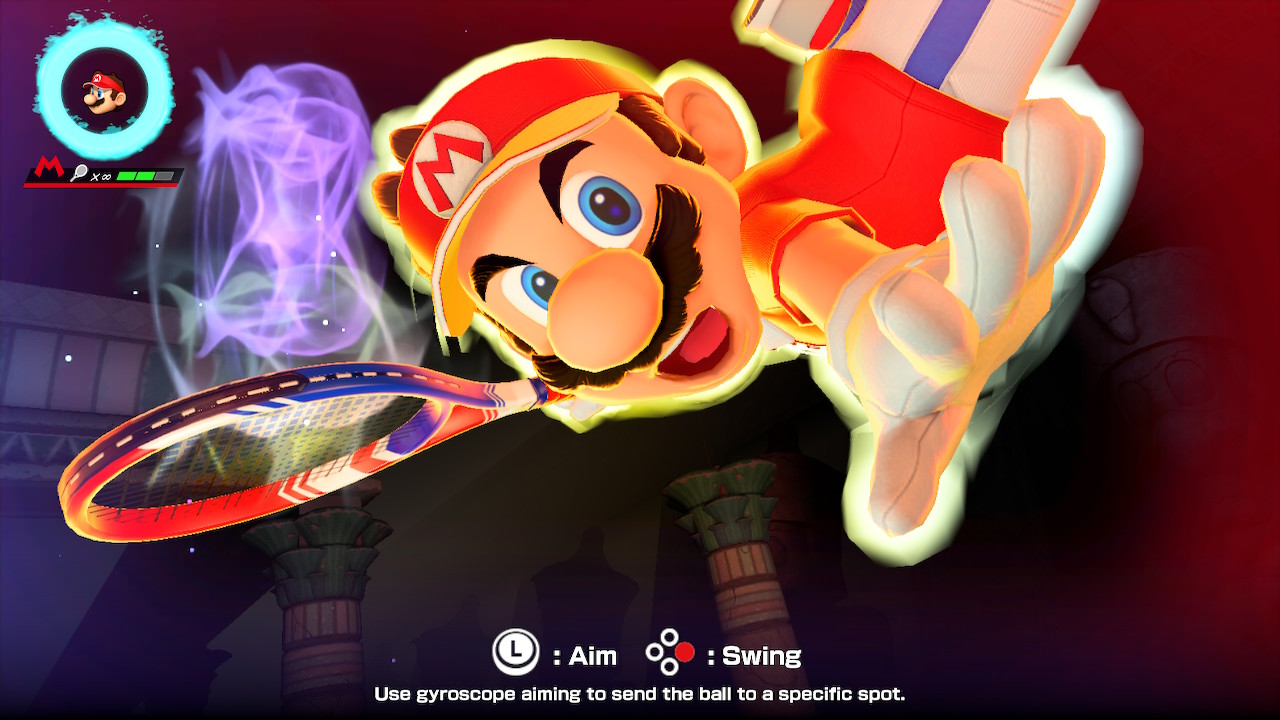
Special Shots require a full Energy Gauge and are racquet shatteringly powerful.
Zone Speed can be triggered at any time by the player by holding down the right shoulder button. This causes the action to slow down to a fraction of its normal speed and, by eating into the player's Energy Gauge, grants the player valuable time to charge across the court and block return them.
Block return shots are delivered by striking the ball at the absolute last moment when the opponent fires a Zone or Special Shot at you. If the player does this successfully then the ball is returned to the opponent and the blocker gets an Energy Gauge boost. Time this badly, striking the ball either too soon or too late, and the raquet's durability will be damaged though. If the racquet's durability score hits zero during the failed block, the racquet will break and the player will automatically lose the point.
Block return shots are delivered by striking the ball at the absolute last moment
Now, naturally, when Zone Speed is activated block returns become rather easy, with the player capable of first reaching the ball, which is typically blasted into the opposite corner of the court that they are currently in, and secondly time the block return shot correctly.
However, and this is something I really didn't like about Mario Tennis Aces, if the player doesn't have any slow-mo Zone Speed energy to call on, then reaching these shots in the first place is almost impossible unless fired directly at or near the player, and timing them very difficult.
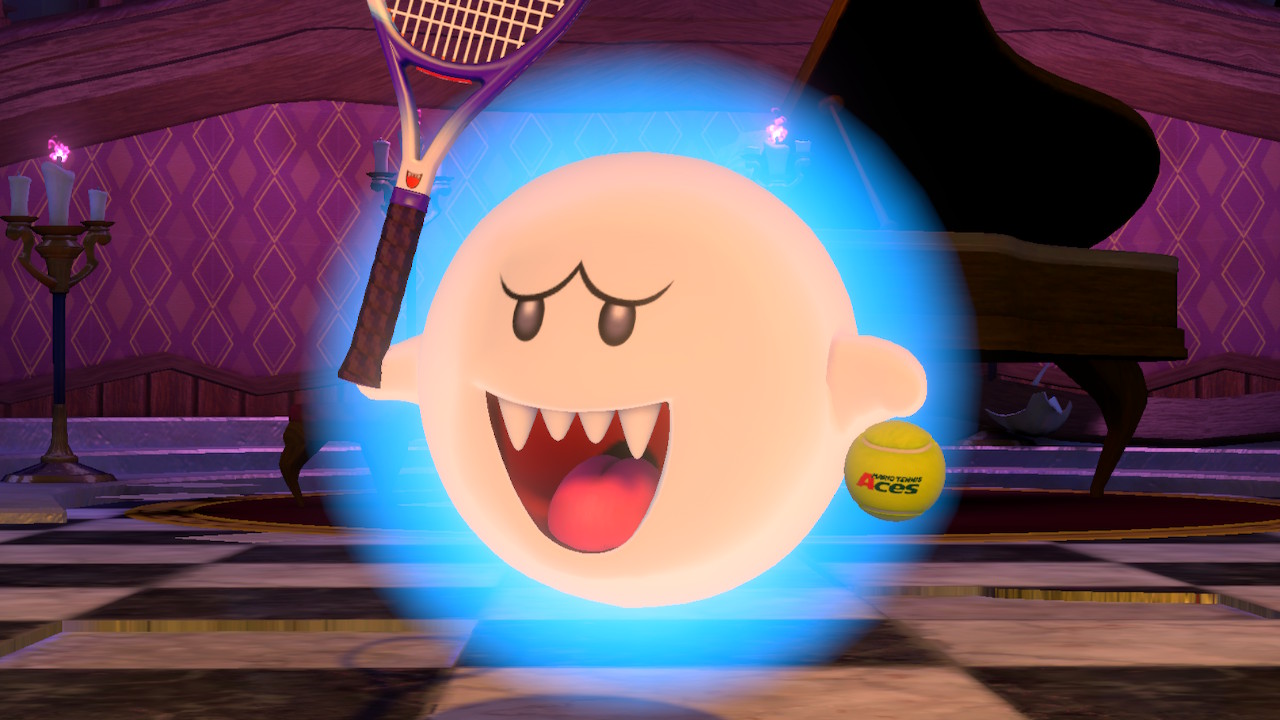
Just how is Boo holding that racquet and ball?
The reality for me when playing Mario Tennis Aces was that 95 per cent of the time when a Zone or Special Shot was fired at my player and I had no Energy Gauge power to call on, I simply watched helplessly as the ball screamed into the opposite corner of the court to win the opponent a point.
These moves simply seemed overpowered and poorly balanced.
Finally, trick shots are special manoeuvres that differ from character to character and are executed by flicking the right stick. These moves are useful for reaching balls during rallies, fooling the opponent, and building up your Energy Gauge power level.
Mario Tennis Aces review: graphics and audio
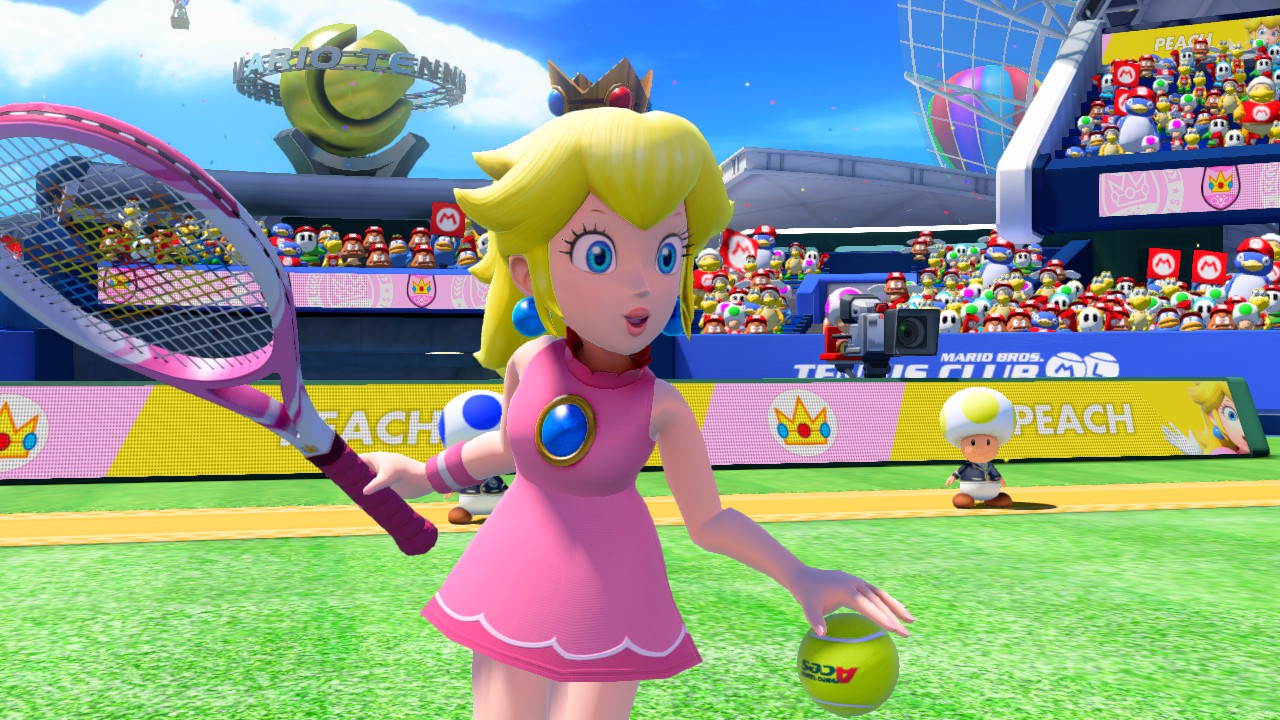
The art style is bright and distinctive in Mario Tennis Aces.
Graphically Mario Tennis Aces is impactful, if not particularly pretty or high fidelity. The art style is typically Nintendo bright and colourful, feeling very much like that in Mario Kart 8 Deluxe, with characters really popping out of the screen.
The environments that players compete in, while restricted in pure size, are also very detailed and full of life, with the Lakitu referee, crowd, and arena in general packed with life and activity.
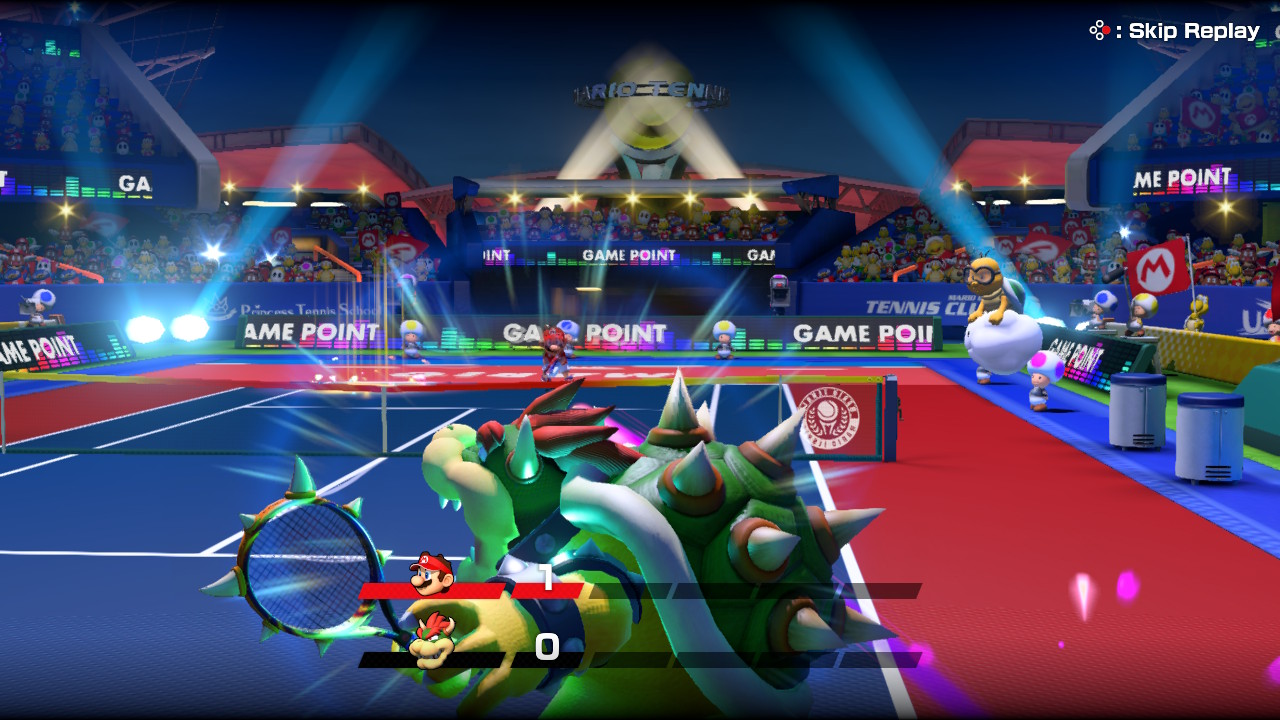
In terms of frame rate, the action in Mario Tennis Aces is smooth and consistent.
On top of the base engine is a series of particle effects, witnessed when special shots are played, trick shots performed, shots are blocked, and racquets broken. These are partnered with a selection of cartoon-style details, like little movement clouds, oration lines, and impact marks.
Music is suitably, if a little generically, great deeds epic, while sound effects distinctive. I can definitely confirm that thwocking the ball backwards and forwards is pleasurable in terms of audio.
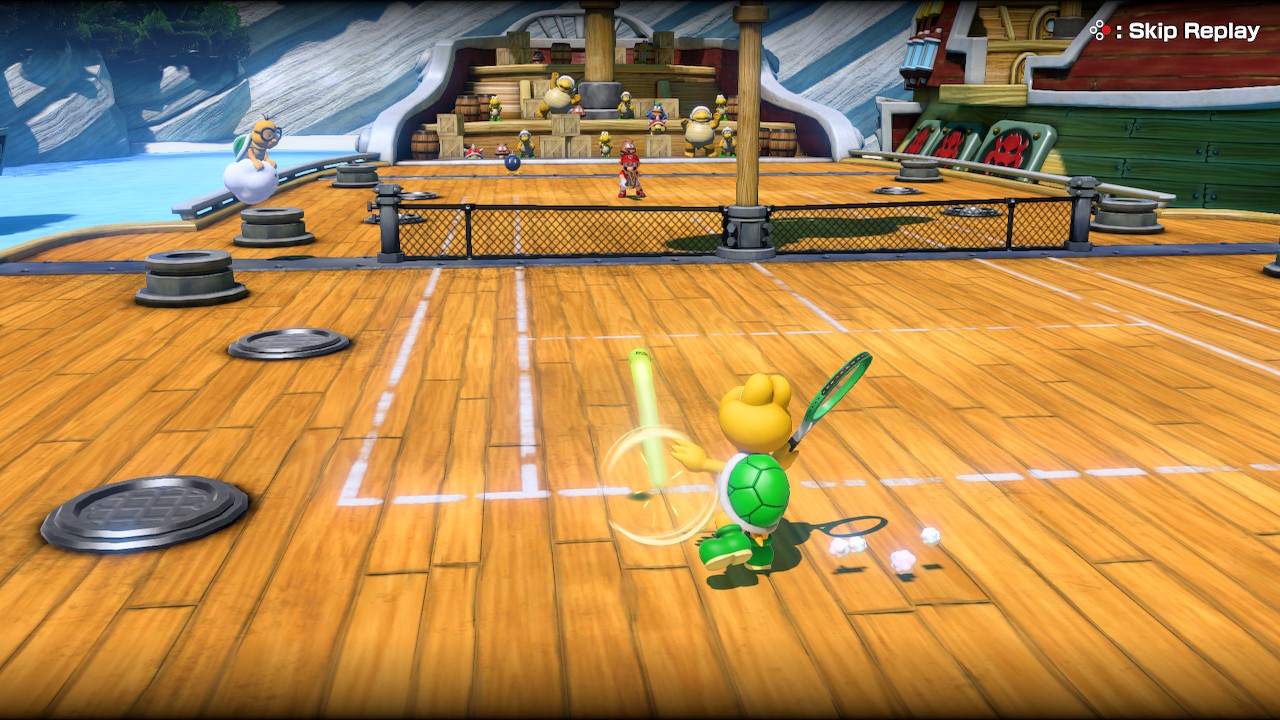
Various particle effects and cartoon detailing adds a level of wackyness to the visuals.
In terms of frame rate, Mario Tennis Aces maintains a smooth and slick experience at all times, which is almost certainly thanks to the relatively simple base engine and small play environments.
Lastly, I can confirm that Mario Tennis Aces adds to that list of Nintendo Switch games that actually looks better on the console's small screen rather than on a large television.
Mario Tennis Aces review: verdict
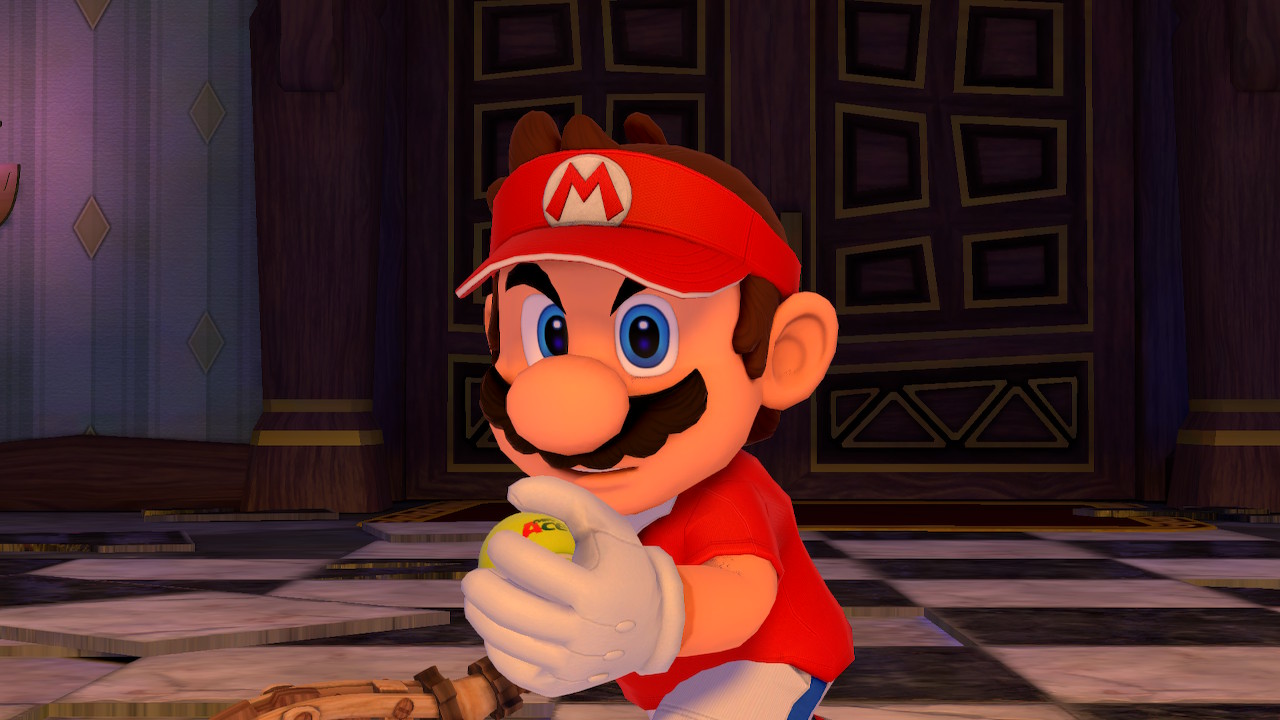
Will Mario deliver an ace? Or will he balloon the ball into the crowd?
Mario Tennis Aces delivers a tennis game that, weirdly, tries as hard as possible to move away from the core game as often as humanly possible. And it does this to mixed results.
While the various mini-game challenges and boss fights in the game's adventure mode deliver variety in terms of action, the execution of them varies in quality and the fact that they are basically mandatory in order to unlock certain equipment and courts, means that you have to fight through them regardless of how fun they actually are to play.

One of the boss characters in Adventure Mode. Yes, it is the two floating hands you've fought before in other titles.
I feel the core game of tennis is rarely allowed to breathe, with it constantly augmented or altered, and this is in my opinion because the core mechanics and gameplay are actually quite flat in Mario Tennis Aces, something that is made apparent if you switch on Simple Rules for a match, which removes the Energy Gauge, Trick Shots, and breakable racquets.
Indeed, as an adult who has played many, many tennis games over the past 20 years or so, I got frustrated by the lack of control or standard ball physics on display in Aces, with rallies never super satisfying and feeling more often than not as merely a means of racing toward a certain energy gauge level to bring the point to a close with a super-powered Zone Shot or Special Shot.
That moment when you resignedly wait for the ball to be drilled into the corner of the court at a racquet-shattering speed is incredibly dispiriting
And the fact that these powerful super shots are basically unreturnable by an opponent unless they have power gauge to burn to enter slow-mo mode, means that you frequently end up beating opponents or being beaten by them before any proper rally gets off the ground. Yes, you obviously can technically block these shots without the use of Zone Speed slow-mo, but unless the ball is delivered remotely close to you then you often don't stand a chance.

Bowser prepares to slam a racquet breaking Zone Shot at Mario.
That moment when the opponent triggers a Zone Shot or, god help you, a Special Shot, you look at your energy bar and see it is empty, and then almost resignedly wait for the inevitable to happen, for the ball to be drilled into the opposite corner of the court to where you are at a racquet-shattering speed, is incredibly dispiriting.
Tournament mode, meanwhile, felt too short, with me blowing through the Mushroom and Flower Cups, and then reaching Bowser in the final of the Star Cup in only two play sessions. Can you replay the various cups with different characters? Well, yeah, but how much you will get out of that will depend on your tastes.
Mario Tennis Aces delivers a match winning performance, but only by the skin of its teeth
Where Aces does pick up and succeed is in casual multiplayer, and specifically with younger players, with me having a good dollop of fun playing on the game with my 8-year-old daughter, who was definitely attracted to the colourful art style and mad roster of playable characters, with Boo and Chain Chomp notable favourites.

Mario wins!
Overall, then, I feel that Mario Tennis Aces delivers a match winning performance, but only by the skin of its teeth. There's definitely fun to be had here, however, I am guessing that for more mature players the game's limitations and balance issues, as well as trite Adventure Mode, will knock some sheen of the purchased package.
Sign up to the T3 newsletter for smarter living straight to your inbox
Get all the latest news, reviews, deals and buying guides on gorgeous tech, home and active products from the T3 experts
Rob has been writing about computing, gaming, mobile, home entertainment technology, toys (specifically Lego and board games), smart home and more for over 15 years. As the editor of PC Gamer, and former Deputy Editor for T3.com, you can find Rob's work in magazines, bookazines and online, as well as on podcasts and videos, too. Outside of his work Rob is passionate about motorbikes, skiing/snowboarding and team sports, with football and cricket his two favourites.
-
 Netflix's most surprising 100%-rated sci-fi series returns with gorgeous trailer
Netflix's most surprising 100%-rated sci-fi series returns with gorgeous trailerLove Death + Robots is back for more
By Max Freeman-Mills Published
-
 Warning: Ciele’s refreshed Elite Collection may cause excessive garment envy on race day
Warning: Ciele’s refreshed Elite Collection may cause excessive garment envy on race dayFlex on your run crew with Ciele’s latest drop
By Matt Kollat Published
-
 Smeg adds a touch of navy sophistication to its iconic breakfast set
Smeg adds a touch of navy sophistication to its iconic breakfast setIt's a minimalist's dream
By Lizzie Wilmot Published